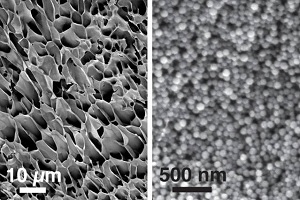 |
| Examples of hydrogel structures at lower (left) and higher (right) magnifications--Courtesy of MIT |
A hydrogel is a polymeric material capable of holding large amounts of water in its 3-D structural network. Because it acts as the gel equivalent of a sponge, hydrogels are ideal for delivering different kinds of drugs and performing necessary functions. This week, hydrogels have shown to be useful in treating inflammatory bowel problems and forming the building blocks of synthetic biological processes such as wound healing.
Researchers at Brigham and Women's Hospital in Boston have published a study in the journal Science Translational Medicine highlighting a hydrogel they used to treat ulcerative colitis. Normally, this requires the administration of drugs through an enema to get directly to the source of the problem in the lower bowels, but using a hydrogel material, the scientists created an oral drug that wouldn't break down before it reaches the affected area, according to a story from the BBC.
The team used a gel called ascorbyl palmitate, considered safe for human consumption, and showed in animal tests that the corticosteroid loaded into the hydrogel stayed in place near the inflamed tissue and leeched into the intestine wall as the gel broke down in the presence of enzymes there. Because the gel stays in place, the treatment requires a smaller dose of the drug--reducing any possible side effects--and could be taken every other day rather than daily.
"We're hopeful that this technology will allow patients to take an enema once a week rather than every day," study author Jeff Karp said in a statement, "and without systemic side effects or the need to retain the enema, as the gel quickly attaches to ulcers, ultimately improving their quality of life."
In other hydrogel news, a team from New York University Polytechnic School of Engineering pulled in a grant from the U.S. Army Research Laboratory to study over the course of the next three years applications for the material to treat wounds, including the delivery of drugs. Hydrogels have been used as wound dressings in the past, and the researchers are looking to improve upon those functions by mimicking biochemical processes found in nature.
The team received $368,000 for their work, spurred by a strong interest in synthetic biology from the Department of Defense.
- here's the BBC story
- and here's the NYU release